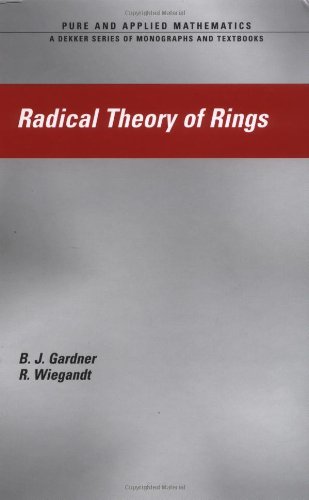J.W. Gardner, R. Wiegandt9780824750336, 0824750330
Table of contents :
Radical Theory of Rings……Page 1
Preface……Page 10
Contents……Page 14
Interdependence Chart……Page 16
List of Standard Conditions……Page 0
List of Standard Conditions……Page 18
List of Symbols……Page 19
1.1. Rudiments……Page 24
1.2. Some elementary ring theory……Page 31
1.3. Skew polynomial rings……Page 37
2.1. Radical classes……Page 43
2.2. Radical constructions……Page 50
2.3. Semisimple classes……Page 53
3.1. Semisimple classes of associative rings……Page 60
3.2. Hereditary radicals and their semisimple classes……Page 66
3.3. Lower radical constructions……Page 72
3.4. The termination of the Kurosh radical construction……Page 75
3.5. The Sulinski-Anderson—Divinsky problem……Page 81
3.6. Supernilpotent radicals and their semisimple classes……Page 86
3.7. Supernilpotent radicals and weakly special classes……Page 94
3.8. Special radicals……Page 100
3.9. Supplementing and dual radicals……Page 110
3.10. Subidempotent radicals……Page 119
3.11. Hypernilpotent and hypoidempotent radicals……Page 122
3.12. Partition of simple rings, unequivocal rings……Page 123
3.13. Minimally ernbeddable rings……Page 129
3.14. Modules and radicals……Page 139
3.15. Radicals defined by properties of ring elements……Page 152
3.16. One-sided hereditary radicals and stable radicals……Page 156
3.17. Strong radicals and strict radicals……Page 163
3.18. Normal radicals……Page 170
3.19. A-radicals……Page 186
3.20. Radical semisimple classes……Page 194
4.1. The principal nil radicals……Page 203
4.2. Separation of the nil radicals……Page 208
4.3. Coincidence of the nil radicals……Page 216
4.4. The Jacobson radical……Page 222
4.5. Structure theorems for Jacobson semisimple rings……Page 228
4.6. One-sided primitivity and idempotent simple quasi-regular rings……Page 238
4.7. Weakly primitive rings……Page 255
4.8. The Brown-McCoy radical……Page 273
4.9. Radicals of matrices and polynomials……Page 276
4.10. Radicals on artinian rings……Page 296
4.11. Concrete hypernilpotent radicals……Page 304
4.12. Concrete hypoidempotent radicals……Page 314
5.1. Degeneracy and pathology of nonassociative radical theory……Page 318
5.2. Sufficient condition for a well-behaved radical theory: Terlikowska-Oslowska’s approach……Page 324
5.3. Sufficient conditions for a well-behaved radical theory: Beidar’s approach……Page 328
5.4. On the radical theory of associative rings with involution……Page 337
5.5. On the radical theory of near-rings……Page 344
References……Page 356

Reviews
There are no reviews yet.